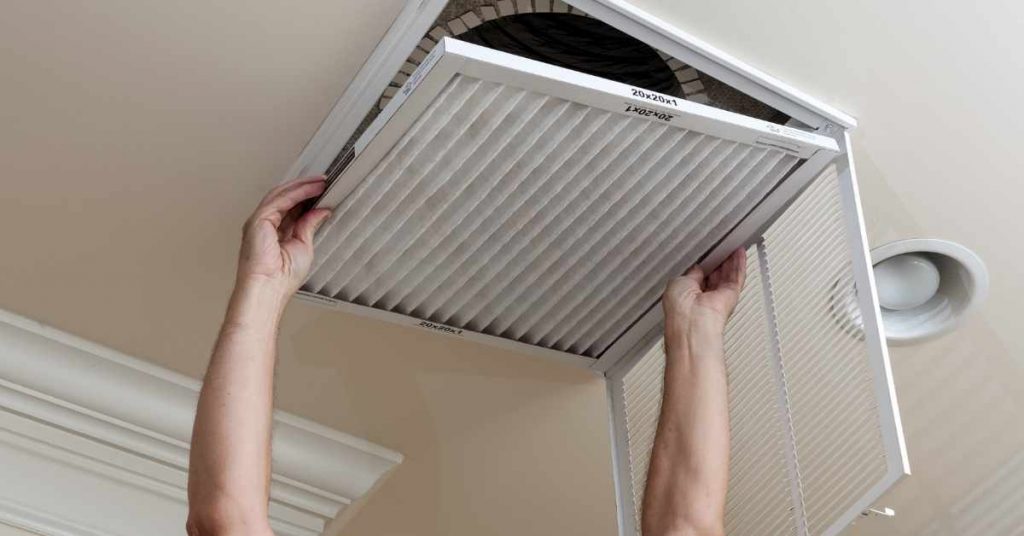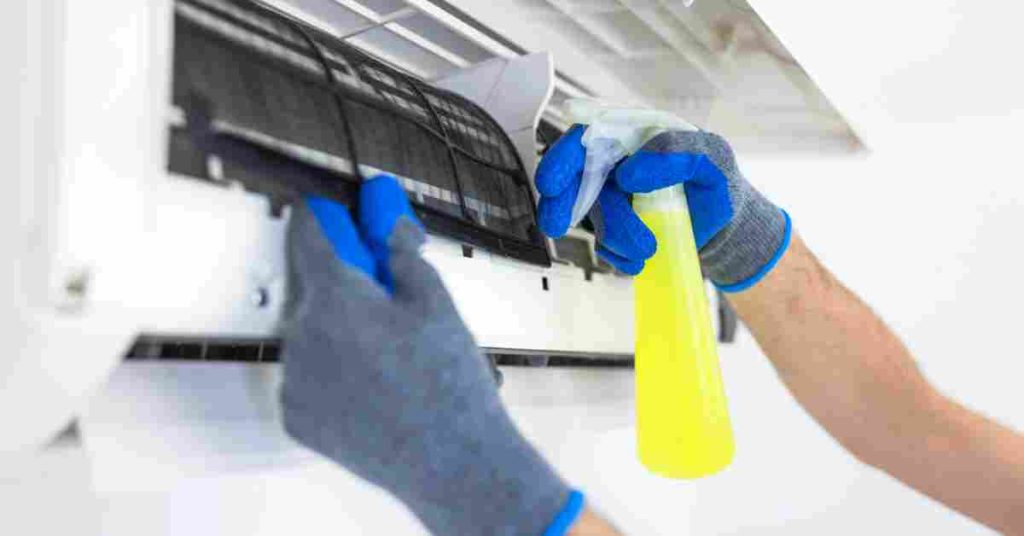Any good HVAC technician will emphasize the importance of proactive A/C system checks at least twice a year, ideally in spring and fall. These regular check-ups can identify and address potential issues before extreme weather hits, ensuring your system operates efficiently. Regular maintenance not only extends the lifespan of your HVAC system but also saves you money in the long run by preventing major breakdowns.

However, if you’ve missed the scheduled maintenance, don’t overlook signs of trouble. Strange sounds or thermostat issues may indicate underlying problems. Calling a professional for a thorough inspection is an investment that can potentially save you hundreds of dollars by catching issues early.
11 Simple Strategies to Beat the Heat Without Breaking the Bank
Follow these simple strategies and you will see your energy bills come down with your Heating and cooling applications:
1. Change Air Filters Regularly

Changing air filters is a simple yet crucial task that many homeowners overlook. According to a survey by American Standard, only about 36% of people regularly change their air filters. This simple preventative measure takes just a few minutes but can significantly impact your A/C efficiency and, consequently, your energy bill.
Anthony Carrino recommends various methods for cleaning air filters, such as using a vacuum or rinsing and air-drying them. Regularly replacing or cleaning filters every 30 to 90 days, as suggested by Kleinschmidt, can save you up to 15% on your monthly energy bill.
2. Keep Your A/C Clean
Ensuring that your air conditioner is clean and well-maintained is crucial for optimal performance. Periodically checking the air ventilator’s intake and exhaust for obstructions is a simple yet effective step. Carrino adds that checking that fan blades are free of dust and dirt is equally important. While homeowners can perform basic cleaning tasks, professional HVAC maintenance should occur at least once a year for a more thorough inspection.
3. Set Up a Thermostat Schedule
Consistency in your thermostat settings can have a significant impact on your energy bills. Kleinschmidt recommends setting your thermostat 7 to 10 degrees Fahrenheit higher when away, potentially saving up to 10% on your electricity bill. This strategic approach to thermostat settings aligns your cooling needs with your daily activities, avoiding unnecessary energy consumption.
Charters suggests a specific summer thermostat setting of 78 degrees Fahrenheit. Every degree cooler increases energy usage between six and eight percent. Developing a thermostat schedule that matches your daily routine is a cost-effective way to regulate your home’s temperature.
4. Check the SEER (Seasonal Energy Efficiency Ratio)
Understanding and evaluating the Seasonal Energy Efficiency Ratio (SEER) of your HVAC system is essential. Carrino advises homeowners to check the SEER, which measures the cooling efficiency of the A/C and heat pump. The higher the SEER number, the better your potential energy savings.
Notably, older units installed prior to 2006 may have a lower SEER ratio. While you can’t optimize the SEER ratio on an old unit, it’s a crucial factor to consider when you’re ready to replace your HVAC system. Carrino emphasizes that a higher SEER rating can save up to 62% on your energy bill each year.
5. Evaluate and Upgrade Windows
Charters recommends evaluating your windows and upgrading them if necessary. New windows with enhanced technology not only improve the appearance of your home but also provide significant energy savings. If the cost of new windows is prohibitive, consider alternative solutions such as blinds, solar screens, or window tinting on south-facing windows to reduce radiant heat.
Charters also emphasize the importance of simple practices, such as closing all blinds and curtains during the day, especially when the A/C or fan is running. These measures contribute to maintaining a cool and energy-efficient home environment.
6. Harness the Power of Fans

While air conditioners are the go-to solution for cooling, homeowners often overlook the benefits of using fans strategically. Carrino recommends investing in stand, box, or ceiling fans as a relatively small investment that can lead to substantial energy savings.
Using fans to help cool your home allows you to raise the thermostat setting by 4 degrees Fahrenheit without compromising comfort. However, Carrino emphasizes the importance of turning off fans when not in use since the “wind chill effect” is for people, not the space itself.
7. Switch to Energy-Efficient Bulbs
Charters advises homeowners to hop aboard the LED train when it comes to lighting. Incandescent, halogen, and fluorescent light bulbs not only use more power than LED bulbs but can also contribute to additional heat during hotter months. Adding a motion detection switch ensures lights are not left on for extended periods when not in use, contributing to both energy efficiency and cost savings.
Additionally, the availability of Wi-Fi-enabled smart bulbs provides an advanced option for homeowners. Smart bulbs, such as the GE Cync Soft White Direct Connect Smart bulbs, can be scheduled and controlled via voice commands with devices like Google Home or Amazon Alexa, offering an additional layer of convenience and efficiency.
8. Install Interior Doors
The design trend of open floor concepts in homes built over the last two decades may contribute to temperature challenges. Charters recommends installing interior doors to close off specific areas, allowing for better zoning of your home. This approach enables more precise temperature management in individual rooms based on varying needs.
Beyond the energy-saving aspect, closing off warmer rooms during the day ensures that the A/C isn’t working overtime to cool spaces that are not in use. This simple yet effective measure aligns your cooling efforts with your immediate needs, contributing to overall energy efficiency.
9. Seal Doors and Windows
Charters underscores the importance of maintaining energy efficiency throughout the year, emphasizing that it’s not a seasonal concern but a year-round consideration. A significant aspect of this effort is sealing any gaps around doors and windows to prevent drafts and heat exchange.
Sealing these gaps can result in savings of up to 10% on your energy bill. Charters notes that homeowners often notice cold drafts around doors during the winter, but these same drafts can have a substantial impact on energy bills during the summer. Consistent attention to door and window seals ensures year-round energy efficiency.
10. Optimize Your Attic
Charters introduces the idea of installing an attic ladder insulation cover to reduce drafts and energy loss. The attic, often overlooked in home energy considerations, can be a significant source of heat exchange. Proper insulation in the attic minimizes the impact of external temperatures on your home’s internal climate.
Addressing potential energy loss through the attic ensures that your A/C doesn’t have to work harder to compensate for drafts. This insulation cover is effectively a barrier that contributes to maintaining a consistent and energy-efficient indoor environment.
11. Wash Clothes in Cold Water
As the summer months bring an increase in outdoor activities, you may find yourself running more loads of laundry. Carrino recommends a simple yet effective way to save money: washing and rinsing clothes with cold water. This practice, if adopted year-round, could lead to an annual savings of around $200.
Taking advantage of sunny weather to air-dry sheets and towels outdoors further enhances the cost-saving aspect. By reducing reliance on the dryer, you not only save on energy costs but also benefit from the natural freshness of line-dried laundry.
Smart Practices for Air Conditioner Users
Beyond implementing home improvements, using your air conditioner efficiently is crucial for achieving the dual goals of staying cool and saving money. Let’s delve into specific smart practices that can enhance your air conditioner’s performance and contribute to energy savings.
1. Correct Installation Matters
Correct installation emerges as a fundamental factor in reducing energy bills related to air conditioners. Incorrect installation can lead to increased workload, reduced efficiency, and higher monthly electricity costs. It’s crucial to enlist the services of trained professionals or authorized service technicians for installation to ensure optimal performance.
Charters highlights the potential risks associated with getting a local handyman to handle installation, emphasizing that incorrect installation may not only compromise efficiency but also void the warranty. Choosing authorized service professionals, such as those provided by TCL, ensures hassle-free installation and prolonged flawless performance.
2. Shield Your AC Unit from Direct Sunlight
The location of your outdoor AC unit can significantly impact its efficiency. Exposure to direct sunlight for extended periods can result in reduced efficiency and increased operational costs. Charters recommends careful consideration of the outdoor unit’s placement to minimize sun exposure.
By installing the outdoor unit in a shaded area or using an awning or cover, you can mitigate the impact of direct sunlight. This proactive approach contributes to optimal A/C performance and ensures that the unit doesn’t have to work harder than necessary.
3. Regular Maintenance and Service

Owning an air conditioner comes with the responsibility of regular maintenance. Wesley Martin, owner of JH Martin Mechanical, stresses the importance of yearly checks to identify and rectify potential issues. During servicing, components are thoroughly inspected, and dust or dirt is cleared from coils.
Martin points out that even a small leak or inefficiency if left unaddressed, can have a significant impact on your energy bill. Regular maintenance not only contributes to optimal A/C performance but also ensures that cool air doesn’t escape from your home, minimizing wear and tear on the system.
4. Avoid Non-Stop Usage
Running your air conditioner continuously, especially when not needed, can strain the entire unit and its components. Charters recommends turning off your AC when not in use, providing the unit with a break, and reducing energy consumption. A strategic approach to A/C usage, possibly through a programmable thermostat, allows for efficient cooling without unnecessary energy expenditure.
5. Set a Reasonable Thermostat Temperature
During the scorching heat of summer, setting your thermostat below 18°C may seem tempting for instant relief. However, Carrino advises against such practices, highlighting that temperatures between 20-25°C are typically comfortable. Setting a temperature within this range prevents the A/C from working overtime and helps you achieve a balance between comfort and energy efficiency.
6. Choose an Energy-Efficient Air Conditioner
The star rating of an air conditioner, provided by the Bureau of Energy Efficiency (BEE), serves as a valuable indicator of its cooling efficiency. Carrino explains that a higher star rating, such as the 5-star rating found in TCL Air Conditioners, translates to more efficient cooling while using less electricity.
Understanding the energy-saving capacity of your specific A/C model, such as TCL’s Elite Series, empowers homeowners to make informed choices. By opting for an energy-efficient air conditioner, you not only cool your room more efficiently but also contribute to long-term cost savings.
In conclusion, achieving a comfortable living space during the summer without incurring exorbitant energy bills requires a multifaceted approach. By thoroughly understanding each aspect of HVAC efficiency, implementing home improvements, and adopting smart usage practices, homeowners can strike the right balance between comfort and savings. Experimenting with these strategies and customizing them to your specific needs ensures that you stay cool without feeling the financial heat during the sweltering summer months.





